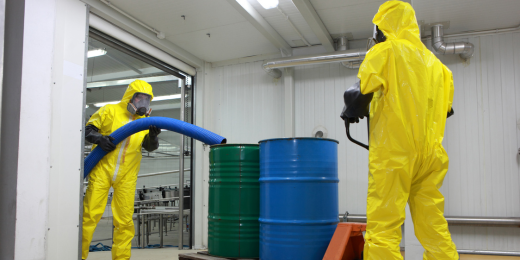The Buzz on Reclaim Waste
The Buzz on Reclaim Waste
Blog Article
Reclaim Waste Can Be Fun For Anyone
Table of ContentsExamine This Report on Reclaim WasteHow Reclaim Waste can Save You Time, Stress, and Money.Some Known Factual Statements About Reclaim Waste The smart Trick of Reclaim Waste That Nobody is DiscussingRumored Buzz on Reclaim Waste
Explore the kinds, occurrences, and kinds of liquid waste. Residential sewage waste describes the waste and products from a residential septic system. This type of waste is developed by people in houses, colleges, and other structures. This only includes septic containers that have a drain field. The correct administration and disposal of residential sewage waste call for liquid waste to be transferred to a sewer treatment plant where the correct methods and devices are applied to cleanse and get rid of waste.
Industrial waste commonly consists of potential hazards, such as flammable materials or a blend of fluid and strong waste items, and requires an advanced and in-depth disposal process. The disposal of industrial waste usually includes the filtering of waste before transportation to make certain secure and appropriate disposal. Industrial waste is produced from by-products and drainage of industrial procedures and production.
This type of waste can not utilize the exact same sewer monitoring transport or processes as septic or commercial fluids. The hazardous waste administration procedure calls for the assessment and screening of liquid waste before it undergoes the disposal procedure (industrial wastewater treatment). Drainage waste is the liquid waste that originates from runoff and excess stormwater in very booming locations or cities
Runoff waste can cause contamination and flooding otherwise dealt with effectively. Find out a lot more regarding drain cleansing and waste administration. Making certain proper waste management can avoid calamities and minimize environmental damage. Both people in property setups and professionals in industrial or manufacturing markets can benefit from comprehending the processes and regulations of fluid waste management.
The Ultimate Guide To Reclaim Waste
Get in touch with PROS Providers today to discover concerning our waste administration and disposal services and the correct methods to look after the fluid waste you produce.
(https://reclaim-waste.jimdosite.com/)This supposed 'wastewater' is not just an important source but, after therapy, will be released to our land, rivers or the ocean. Utilized water from commodes, showers, baths, cooking area sinks, washings and industrial processes is recognized as wastewater.

water made use of to cool down machinery or tidy plant and equipment). Stormwater, a type of wastewater, is drainage that flows from farming and city areas such as roof coverings, parks, gardens, roadways, paths and seamless gutters right into stormwater drains pipes, after rain. Stormwater moves without treatment straight to neighborhood creeks or rivers, eventually reaching the ocean.
Some Known Details About Reclaim Waste
In Queensland, most wastewater is dealt with at sewer treatment plants. Wastewater is carried from domestic or industrial sites through a system of sewage systems and pump terminals, known as sewerage reticulation, to a sewer therapy plant.
The Department of Natural Resources encourages city governments concerning managing, operating and maintaining sewage systems and treatment plants. In unsewered locations, neighborhood federal governments may require owners to set up private or family sewage therapy systems to deal with domestic wastewater from toilets, cooking areas, washrooms and washings. The Department of Natural Resources authorises using family systems when they are shown to be effective.
In some new neighborhoods, therapy of some stormwater to remove trash, sand and gravel has actually started utilizing gross toxin catches. Wastewater therapy occurs in 4 stages: Gets rid of strong matter.
Wastewater then flows right into huge containers where solids clear up and are removed as sludge. Grease and residue are skimmed from the surface area. Utilizes little living organisms understands as micro-organisms to damage down and eliminate continuing to be dissolved wastes and great particles. Micro-organisms and wastes are integrated in the sludge. Eliminates nitrogen and phosphorus nutrients that can cause algal flowers in our waterways and intimidate marine life.
Rumored Buzz on Reclaim Waste
Nutrient elimination is not readily available in all sewage treatment plants because it calls for expensive specialised equipment. It is becoming more common in Queensland. Clear liquid effluent created after treatment might still have disease-causing micro-organisms. If this effluent is launched into waterways such as additional resources rivers or the sea, the micro-organisms will at some point pass away out.

This typically indicates wastewater has to be dealt with or impurities eliminated prior to it can be released to rivers. Many wastewater moves right into the sewerage system. Under the Act, local governments carry out approvals and licences for eco appropriate tasks (Ages) involving wastewater launches that may have a neighborhood influence. The department carries out approvals and permits to Ages involving wastewater launches that might have a local or statewide effect.
Little Known Facts About Reclaim Waste.
Or else, examples are taken for lab evaluation. Typically several tests are needed to establish the levels of each of the different pollutants such as oils, hefty steels and pesticides in water. Tracking offers valid details regarding water quality and can confirm that permit conditions are being met. The information obtained through tracking offers the basis for making water quality decisions.
Report this page